
Apios priceana is a rare species of flowering plant in the legume family known by the common names Price's potato-bean, Price's groundnut, and traveler's delight. It is a climbing yellow-green vine in the growing from a stout, potato-like tuber. It is native to the U.S. states of Alabama, Mississippi, Kentucky, and Tennessee. It occurred in Illinois in the past but its population there was destroyed. There are about 25 known occurrences. It is federally listed as a threatened species.
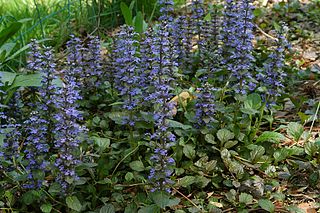
Ajuga reptans is commonly known as bugle, blue bugle, bugleherb, bugleweed, carpetweed, carpet bugleweed, and common bugle, and traditionally but less commonly as St. Lawrence plant. It is an herbaceous flowering plant, in the mint family, native to Europe. It is invasive in parts of North America. Ajuga reptans is also a component of purple moor grass and rush pastures, a Biodiversity Action Plan habitat in the United Kingdom.

Pseudopanax arboreus or five finger, is a New Zealand native tree belonging to the family Araliaceae. It is one of New Zealand's more common native trees, being found widely in bush, scrub and gardens throughout both islands. The compound leaves with five to seven leaflets, hence the common name, are very characteristic of the tree and easily recognized.
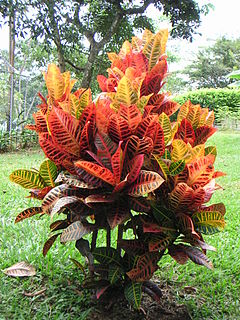
Codiaeum variegatum is a species of plant in the genus Codiaeum, which is a member of the family Euphorbiaceae. It was described by Carl Linnaeus in 1753. It is native to Indonesia, Malaysia, Australia, and the western Pacific Ocean islands, growing in open forests and scrub.

Stachys byzantina, the lamb's-ear or woolly hedgenettle, is a species of flowering plant in the mint family Lamiaceae, native to Turkey, Armenia, and Iran. It is cultivated over much of the temperate world as an ornamental plant, and is naturalised in some locations as an escapee from gardens. Plants are very often found under the synonym Stachys lanata or Stachys olympica.

Rosa chinensis, known commonly as the China rose or Chinese rose, alternatively known as Bengal rose or Bengal Crimson or Bengal Beauty is a member of the genus Rosa native to Southwest China in Guizhou, Hubei, and Sichuan Provinces. The first publication of Rosa chinensis was in 1768 by Nikolaus Joseph von Jacquin in Observationum Botanicarum, 3, p. 7, p. 55.
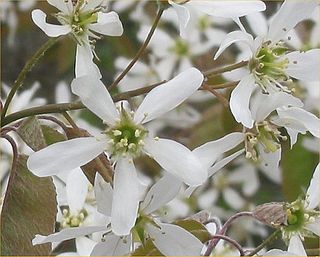
Amelanchier canadensis is a species of Amelanchier native to eastern North America in Canada from Newfoundland west to southern Ontario, and in the United States from Maine south to Alabama. It is largely restricted to wet sites, particularly on the Atlantic coastal plain, growing at altitudes from sea level up to 200 m.

Symphyotrichum laeve is a flowering plant native to Canada and the United States. It has the common names of smooth blue aster, smooth aster, smooth-leaved aster, glaucous Michaelmas-daisy and glaucous aster.
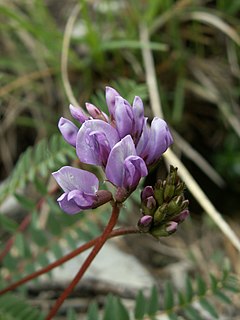
Oxytropis is a genus of plants in the legume family. It is one of three genera of plants known as locoweeds, and are notorious for being toxic to grazing animals. The other locoweed genus is the closely related Astragalus. There are about 300 species, native to Eurasia and North America. Several species are native to the Arctic. These are hairy perennial plants which produce raceme inflorescences of pink, purple, white, or yellow flowers which are generally pea-like but have distinctive sharply beaked keels. The plant produces legume pods containing the seeds.
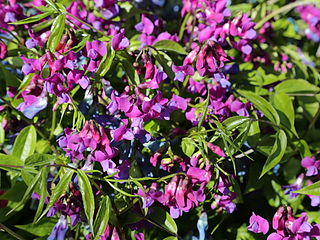
Lathyrus vernus, the spring vetchling, spring pea, or spring vetch, is a species of flowering herbaceous perennial plant in the genus Lathyrus, native to forests of Europe and Siberia. It forms a dense clump of pointed leaves with purple flowers in spring, shading to a greenish-blue with age.
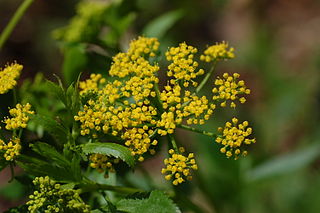
Zizia aurea is a flowering herbaceous perennial plant of the carrot family Apiaceae. It is native to eastern Canada and the United States, from the eastern Great Plains to the Atlantic Coast. Named for Johann Baptist Ziz, a German botanist.

Fumaria muralis, known as common ramping-fumitory or wall fumitory, is a flowering herbaceous plant in the poppy family (Papaveraceae) native to western Europe and northwestern Africa.

Paeonia daurica is a perennial herbaceous plant belonging to the peony family. It has slender carrot-shaped roots, leaves mostly consisting of nine leaflets, with one flower per stem. The flower is subtended by none to two leafy bracts, and has two or three sepals, five to eight petals, and many stamens. The subspecies vary in the colour of the petals, the size and shape of the leaflets, and the hairiness of the leaflets and the carpels. Paeonia daurica can be found from the Balkans to Iran, and the Crimea to Lebanon, with the centre of its distribution in the Caucasus. It is also cultivated as an ornamental.

Oxytropis lambertii is a species of flowering plant in the legume family known by several common names, including purple locoweed, woolly locoweed, and Lambert crazyweed.

Thelypodium stenopetalum is a rare species of flowering plant in the mustard family known by the common names slenderpetal thelypody, slender-petaled thelypodium and slender-petaled mustard. It is endemic to the San Bernardino Mountains of southern California, where it is known from only three or four extant occurrences in moist mountain meadows near Big Bear Lake. Its remaining habitat is considered seriously threatened and the plant is a federally listed endangered species in the United States.

Clitoria fragrans is a rare species of flowering plant in the legume family known by the common name pigeon wings, or sweet-scented pigeon wings. It is endemic to Central Florida, where it was known most recently from 62 occurrences, but no current estimates of the total global population are available. The plant is a federally listed threatened species of the United States.

Escobaria sneedii is a rare species of cactus known by the common names Sneed's pincushion cactus and carpet foxtail cactus. It is native to the Chihuahuan Desert, where it occurs in scattered locations in New Mexico, Texas, and Chihuahua. Some plants occurring in Arizona may be included within this species. Botanical authors do not necessarily agree on the circumscription of this species. Most will agree at this point in the research, however, that there are two varieties of Escobaria sneedii, and that both are rare and endangered. The plant is popular with cactus enthusiasts and dealers because of its often petite size and tolerance for moderately cold climates. They have been overharvested from their natural habitat, the main reason why the two varieties, var. sneedii and var. leei, have been federally listed as endangered and threatened, respectively.

Lespedeza leptostachya is a rare species of flowering plant in the legume family known by the common names prairie lespedeza and prairie bush-clover. It occurs in the Upper Midwest region of the United States. The flowers are creamy-white to purplish and arranged into a narrow terminal spikes.

Centrosema virginianum is known by the common names of Spurred Butterfly Pea, wild blue vine, blue bell, and wild pea. C. virginianum is a member of the family Fabaceae, it is identified by its trailing and twining vine and showy flowers. C. virginianum habitats are in sunny areas within pine lands, and coastal uplands.

Oxytropis prenja G. Beck in Reichenb. & Reichenb. Fil. is a species of flowering plant in the legume family, Fabaceae.





















